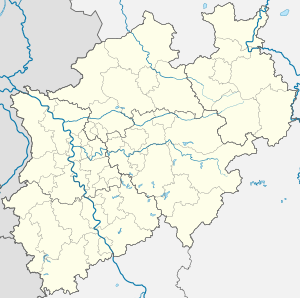Mettmann
Mettmann is a town in the northern part of the Bergisches Land, in North Rhine-Westphalia, Germany. It is the administrative centre of the district of Mettmann, Germany's most densely populated rural district. The town lies east of Düsseldorf and west of Wuppertal.
Mettmann | |
|---|---|
 Coat of arms | |
Location of Mettmann within Mettmann district   | |
 Mettmann  Mettmann | |
| Coordinates: 51°15′N 6°58′E | |
| Country | Germany |
| State | North Rhine-Westphalia |
| Admin. region | Düsseldorf |
| District | Mettmann |
| Government | |
| • Mayor | Thomas Dinkelmann |
| Area | |
| • Total | 42.52 km2 (16.42 sq mi) |
| Elevation | 125 m (410 ft) |
| Population (2018-12-31)[1] | |
| • Total | 38,829 |
| • Density | 910/km2 (2,400/sq mi) |
| Time zone | CET/CEST (UTC+1/+2) |
| Postal codes | 40822 |
| Dialling codes | 02104 |
| Vehicle registration | ME |
| Website | www.mettmann.de |
Brief history
Located on the ancient trade route "strata coloniensis" the Lotharingian hamlet of Medamana (engl. between the streams, which bears an etymological similarity to the origins of the name for the Northern Italian city of Milan (lat. Mediolanum)) first appeared in the charter of the last Carolingian King, Louis the Child, 904 AD, thus existing "officially" for more than 1100 years.
In 1363 Mettmann was one of eight administrative burghs in the Earldom of Berg and Jülich. Later the burgh became independent at the hand of Counsellor to the Earl of Cleves and was allowed to build a wall and choose a mayor. The ability to toll and tax allowed the burgh to develop in commerce and trade.
In 1806 Mettmann became a part of the Grand Duchy of Berg under the rule of Napoleon's brother-in-law, Joachim Murat. During this time, Mettmann's burgomaster was called "Monsieur le Maire." Mettmann remained French for about 10 years and became a part of Prussia's Province of Jülich-Cleves-Berg following Napoleon's defeat at the Battle of Leipzig in 1813. As the result of the Congress of Vienna (1814–15), in 1822 it was adsorbed into the Prussian Rhine Province.
However, the Prussian rulers did not prove to be very popular, as during the bread-riots of 1848–49 and the ensuing political upheavals, which hit the district of Düsseldorf among the hardest, policing was done from Berlin, excluding local accountability. Thus, the Prussian government regarded the Rhinelands as more of a colony, furnishing the bureaucracy, which was based in Düsseldorf, with civil servants that were drafted in from other regions of Prussia.
Mettmann was liberated from the National Socialist Dictatorship April 16th, 1945 by a vanguard of the US Ninth Army and then became a part of the British military administration under which the Northern Rhineland was redemocratised. Since 1946, Mettmann is a part of the Land North Rhine-Westphalia and from 1949 of West Germany. Since 1990 it belongs to the unified Federal Republic of Germany.
Gallery
- Church (die Sankt Lambertuskirche) from Flintropstrasse
 Churchtower (die Sankt Lambertuskirche) in the street
Churchtower (die Sankt Lambertuskirche) in the street Reformed church
Reformed church View to a street: der Markt
View to a street: der Markt
Government and politics
Mettmann gave its name to the District of Mettmann. Although the administrative centre of the District of Mettmann changed often over the years, in 1954 the parliament of the Land North Rhine-Westphalia eventually decided to make Mettmann the district's administrative centre. In 1974–75, with the administrative boundary reform, the district lost several councils to the neighbouring cities Düsseldorf, Duisburg, Essen, and Wuppertal. The district name also changed from Düsseldorf-Mettmann to Mettmann during this reform. However, the regional Board of Inland Revenue—the "Finanzamt Düsseldorf-Mettmann"—serves both the municipalities forming the district of Mettmann, as well as the city of Düsseldorf proper.
Sites of interest
In the nearby Neanderthal, in the summer of 1856, quarry workers discovered the fossilised remains of what became known as the Neanderthal man or Homo neanderthalensis in Feldhof cave.
- Neanderthal Museum in Neanderthal
- Historical downtown with central market, mansions typical black slate lining
- Town Museum
- Goldberger Mill in Mettmann Stadtwald
Demographics
As of 1945, Mettmann's population rose as a result of the resettlement of people - most of whom considered themselves as having ethnic or cultural ties with Germany, and the arrival of migrant workers from the Mediterranean region . Aside from its Rhenish-Westphalian majority population in Mettmann, there are also communities of Turks, Kurds, Kashubians, Old Prussians, Silesians, Poles, Greeks, Croatians, Serbs, Albanians, Bosnians and Lebanese.
Since German reunification Mettmann witnessed an influx of inhabitants of the new German laender due to the economic downturn in their home regions. Mettmann also hosts the Brazilian community featured in the German movie Samba in Mettmann by the German/Italian filmmaker duo Hape Kerkeling and Angelo Colagrossi.[2]
Notable people
- Joachim Neander
- Konrad Heresbach, reformer, Calvinist, Humanist and educator
- Johannes Flintrop
- Andreas Frege
- Thomas Huber
- Andreas Meurer
- Kristina Bach, German chanteuse
- Martin Kaymer, Professional golfer
- Frank Kschischang, Electrical Engineering Professor at University of Toronto
International relations
References
- "Bevölkerung der Gemeinden Nordrhein-Westfalens am 31. Dezember 2018" (in German). Landesbetrieb Information und Technik NRW. Retrieved 10 July 2019.
- "Samba in Mettmann", Internet Movie Database, accessed 17.06.2017
- "Partnerstädte, Patenschaften und Freundschaften". mettmann.de (in German). Mettmann. Retrieved 2019-12-03.
External links
- Homepage of the City of Mettmann (in German)
- Homepage of the District of Mettmann (in German)
- Homepage of the Neanderthal museum (in English)
| Wikimedia Commons has media related to Mettmann. |